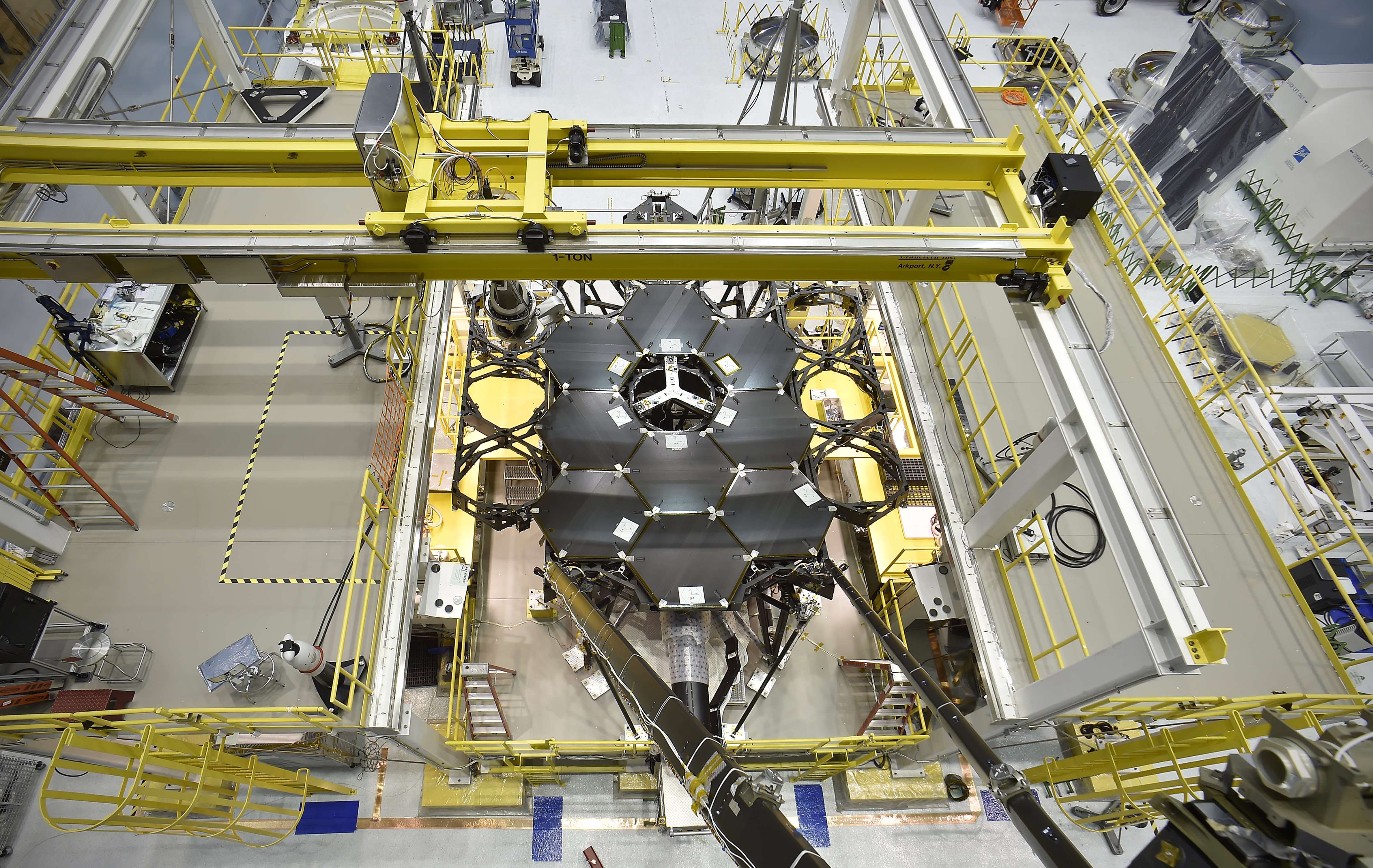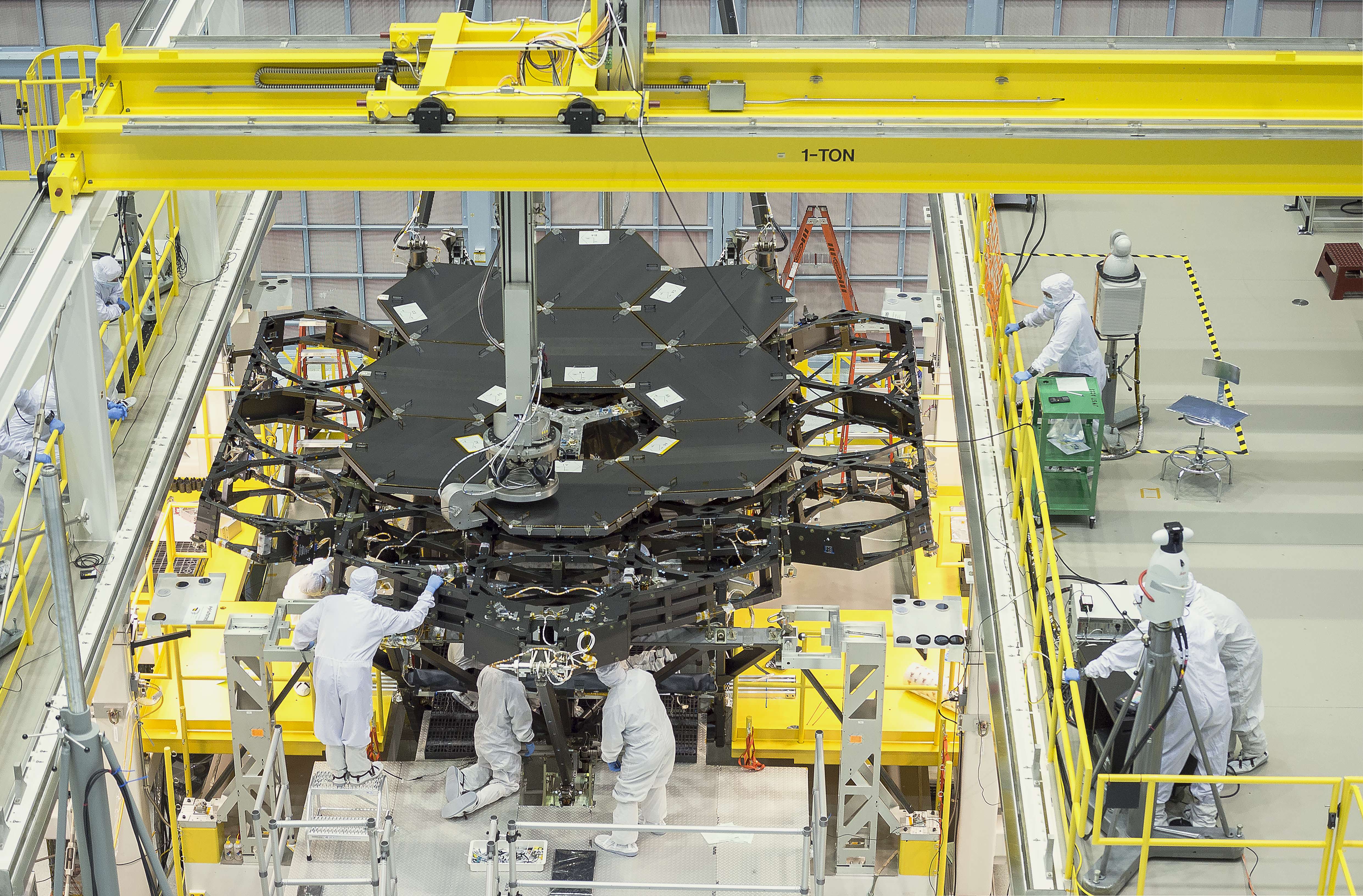

This rare overhead shot of the James Webb Space Telescope shows the nine primary flight mirrors installed on the telescope structure in a clean room at NASA's Goddard Space Flight Center in Greenbelt, Maryland. Credits: NASA's Goddard Space Flight Center/Chris Gunn
As history closes in on 2015, assembly of NASA’s James Webb Space Telescope (JWST) reached a historic milestone as the installation of the primary mirrors onto the telescope structure reached the halfway point to completion and marks the final assembly phase of the colossal observatory.
Technicians have just installed the ninth of 18 primary flight mirrors onto the mirror holding backplane structure at the agency’s Goddard Space Flight Center in Greenbelt, Maryland.
The team is using a robotic arm to carefully but diligently attach each mirror to the structure of the gargantuan observatory that will eventually become the most powerful telescope ever sent to space – exceeding Hubble!
“This fall we started installing every mirror,” said Sandra Irish, JWST lead structural engineer during a recent interview with Universe Today at the NASA Goddard clean room facility.


The painstaking assembly work to piece the mirrors together began when the first unit was successfully installed onto the central segment just before the Thanksgiving 2015 holiday.
Working inside the massive clean room at NASA Goddard dedicated to the task, the engineering team manipulates the huge robotic arm to precisely lift and lower each gold coated mirror into place onto the observatory’s critical mirror holding backplane assembly.
“We are in good shape with the James Webb Space Telescope,” said Dr. John Mather, NASA’s Nobel Prize Winning scientist, in a recent exclusive interview with Universe Today at NASA Goddard.
The actual flight mirror backplane is comprised of three segments – the main central segment and a pair of outer wing-like segments holding three mirrors each.
One by one the team has first been populating the 12 unit central segment of the telescope structure with the primary mirrors at a pace of roughly two per week since the installations started some five weeks ago.
The mirrors are currently covered with a black colored cover to protect them from optical contamination during the installation process.
The pair of foldable side mounted wings at both sides, each holding a trio of mirrors, remain empty as of now.
The wings have been unfolded from the stowed-for-launch configuration to the “deployed” configuration to carry out the mirror installation. They will be folded back over into launch configuration for eventual placement inside the payload fairing of the Ariane V ECA booster rocket that will launch JWST three years from now.
Each of the 18 hexagonal-shaped primary mirror segments measures just over 4.2 feet (1.3 meters) across and weighs approximately 88 pounds (40 kilograms).
In space, the individual mirrors will unfold into several sections and work together as one large 21.3-foot (6.5-meter) mirror, unprecedented in size and light gathering capability.
To complete the entire mirror installation process onto the backplane assembly will take several months and continue into early 2016, Irish told Universe Today.
The flight structure and backplane assembly serve as the $8.6 Billion Webb telescopes backbone.
“The backplane structure was designed and built at Orbital ATK with NASA oversight,” Irish explained. The assembly work was done at the firms facilities in Magna, Utah.
The telescope will launch from the Guiana Space Center in Kourou, French Guiana in 2018.
The telescopes primary and secondary flight mirrors had previously arrived at Goddard and the teams had practiced the installation using flight spares and engineering units.
“The years of planning and practicing is really paying dividends and the progress is really rewarding for everyone to see,” said NASA’s Optical Telescope Element Manager Lee Feinberg, in a statement.
“This starts the final assembly phase of the telescope.”
The mirrors were built by Ball Aerospace & Technologies Corp., in Boulder, Colorado. Ball is the principal subcontractor to Northrop Grumman for the optical technology and lightweight mirror system. The installation of the mirrors onto the telescope structure is performed by Harris Corporation of Rochester, New York. Harris Corporation leads integration and testing for the telescope, according to NASA.
“Then next April 2016 we will install the ISIM science module inside the backplane structure,” Irish elaborated.
The Webb Telescope is a joint international collaborative project between NASA, the European Space Agency (ESA) and the Canadian Space Agency (CSA).
JWST is the successor to NASA’s 25 year old Hubble Space Telescope.
Webb is designed to look at the first light of the Universe and will be able to peer back in time to when the first stars and first galaxies were forming.
“JWST has the capability to look back towards the very first objects that formed after the Big Bang,” Mather told Universe Today.
NASA has overall responsibility and Northrop Grumman is the prime contractor for JWST.
“James Webb has a much bigger mirror than Hubble. So its resolution is much better,” said astronaut and NASA science chief John Grunsfeld, during an exclusive interview with Universe Today at NASA Goddard. Grunsfeld flew on a trio of Hubble servicing missions aboard the Space Shuttle, including the final one during STS-125 in 2009.
“JWST can look back further in time, and a greater distance than Hubble, so we can see those first stars and galaxies formed in the Universe.”
So its 9 down and 9 mirrors to go!
Watch for more on JWST construction and mirror installation.
Stay tuned here for Ken’s continuing Earth and Planetary science and human spaceflight news.
Astronomers have developed several versions of rotating liquid metal telescopes, which use the force of…
One planet was missing from the sunset lineup… until now. Perhaps you’ve seen the news…
The giant-impact hypothesis posits that billions of years ago a Mars-sized body named Theia collided…
What can Venus atmospheric samples returned to Earth teach us about the varied evolution of…
Type 1a supernovae are extremely powerful events that occur in binary systems containing at least…
What's the story of our Moon's early history? Despite all we know about our closest…